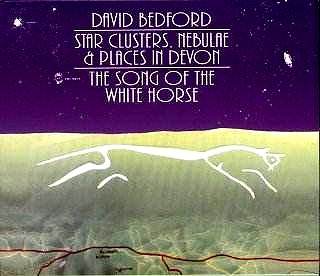David Bedford studied at the Royal Academy of Music
with Lennox Berkeley though Berkeley left no obvious imprint on Bedford's
music. Of lucid relevance are the years spent with Luigi Nono and the
Milan Electronic Studios. His concerns are treated in Carolyn Stokoe's
essay in the book 'British Music Now' (ed. Lewis Foreman), 1974. He
is gripped by sounds rather than by technical musical processes or mathematical
paradigms. His style is said to be essentially simple admitting a flexible
and direct means of expression.
These recordings which in their combined timing suggest
LP era provenance take us on a journey to the ultima thule realms of
the 1970s. I cannot help thinking that Ligeti also spoke in clear and
beguiling tones to the young composer. If the music sometimes suggests
a lost choral chapter from the score of 2001-A Space Odyssey
I say this only to orientate your ears if you have not heard Bedford
before. Star Clusters brings back all those memories of 1970s
broadcasts from the Round House Proms. It has a great spatial sense
and considerable radiant grandeur counting it into the 'High Hills'
glories of the English choral tradition. Of course with Bedford nothing
is quite that straightforward. The singers are required to chatter (20.09)
and cackle at times for all the world like a flock of penguins and at
other times their aureate tone reaches outward in a dazzling glow. The
words do not matter greatly except that they provide syllabic interest
and in some measure function as a mantra or spell. The two choirs each
have their own set of words. Choir 1 sing names such as Ring Nebula
in Hydra along with 21 others while choir 2 sing the names of places
in Devon including Starcross, and Hope's Nose both names which evoke
warm summers and cold winters fishing with my father during my very
early teenage years. The choral writing steps out in audacious directions
from the pages of Hymnus Paradisi and at the close there is a
jubilant rocking quality which I last heard in the alleluias in Hilding
Rosenberg's Symphony No. 4 Johannes Uppenbarelse. Disconcertingly
the work just ends.
The Song of the White Horse was written for
a BBCTV Omnibus programme in 1978. It is in five sections depicting
a journey along the Ridgeway in the South of England. The five sections
(of which the last two have parts for voices) start with Prelude - Wayland's
Smithy which uses a small cell-sequence ostinato played on the synthesiser
keyboard. This is shadowed and full of mystery. To this extent only
Bedford stands not that far from John Ireland who also showed sympathy
(in Mai-Dun and Forgotten Rite) for the distant past of
the British landscape and a suspicion of 'chocolate box' rural beauty.
The White Horse has a majestic chorale and a wildly playful synthesiser
keyboard that sounds now just slightly dated. The third section is The
Blowing Stone which uses a tape of Bedford blowing into the stone
at the foot of the hill of the White Horse. The sound is primeval and
disturbing and is echoed in more civilised casing by the brass. That
sound returns in section 4 when the choir sings of King Alfred calling
for the blowing of warhorns.
A demerit in this disc is the lack of internal tracking.
There are only two tracks one for each work. Documentation is well presented
and the card case design is excellent. The words are printed on the
case.
The singer of the Song (section 4) is a youthful girl
Diana Coulson and the long poem (also set by John Gardner) by the currently
still unfashionable G K Chesterton is sung first by Coulson (who returns
for the Postlude) and the children's choir from Queen's College. The
setting is sung in a flat mesmerising way which enhances the sense of
distant times and events - part evocation and part invocation. The voices
are gradually joined by instrumental decoration lie flames licking at
the heels of the choir.
The 'White Horse' of the title is the giant horse cut
from the green turf to reveal the chalky white since time immemorial
from the downlands as a memorial to the victory of King Alfred over
the Danish King Guthrum. The horse is there to this day in Uffington
and can be seen from the road and main railway line.
The tapes were produced and engineered by the composer.
Rob Barnett
See also review by
Gary Dalkin


